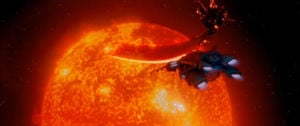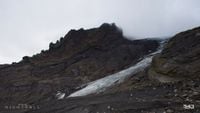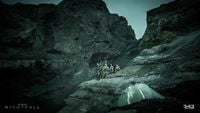Alpha Shard
From Halopedia, the Halo wiki
| Alpha Shard | |
|---|---|

| |
| General overview | |
|
Description: |
Fragment of Installation 04 |
|
Location: |
Location 6201[1] |
|
Gravitational anchor: |
Unidentified red giant |
| Operation overview | |
|
Date of construction: |
Before c. 100,000 BCE |
| Structural information | |
|
Surface area: |
96 km2[2] |
|
Surface width: |
318 kilometres (198 mi)[3] |
|
Atmospheric composition: |
Breathable |
Alpha Shard is a surviving fragment of Installation 04 that escaped the ring's destruction in 2552 via an emergency slipspace jump.[1]
History
When the UNSC Pillar of Autumn's reactors went critical on September 22, 2552, Installation 04 attempted to activate a safety measure and make a slipspace jump. However, this self-preservation protocol was only partly successful, and only a small portion of the ring—a shard with a surface area of 96 km2,[2] later designated Alpha Shard—managed to enter slipspace before the Autumn's reactors overloaded and destroyed the ring. The surviving fragment of the Halo reentered normal space in the vicinity of a red giant star some distance away from the Orrichon system and was caught in the giant star's orbit.[1]
While most of the debris of Installation 04 either fell into Threshold's or Basis' gravity wells or remained in the orbital debris field, at least 30% of the mass and curvature remained unaccounted for by the UNSC. In late 2555, the Office of Naval Intelligence took note of information recorded by an Automated UNSC Scout Vehicle, Recon-14, in an area designated Location 6201. Recon-14 had been deployed from the Pillar of Autumn before the ship's crash-landing on the Halo installation. The signal data from the drone was analyzed by multiple ONI specialists, among them ONI attaché for astrophysical phenomena Dr. Madeline Tress. She correctly concluded that the signal originated from the missing fragment of Installation 04, indicating that a part of the ring either generated or was enveloped in a significant slipspace event, one far exceeding the capabilities of either human or Covenant technology.[1]
Uniquely, the extreme heat of the Autumn's explosion, comparable to temperatures produced by a supernova, caused the formation of an entirely new element in a small area of the fragment—one not found elsewhere in the known universe. This element was later illegally mined from the fragment and smuggled to human colonial space, specifically Sedra. It was discovered that the element caused catastrophic breakdown of DNA in certain humans but did not affect other species. The element was refined into a bioweapon which a Sangheili terrorist unleashed in Sedra City, killing or hospitalizing many of the planet's citizens. A joint ONI-Sedran Colonial Guard team led by Lt. Commander Locke embarked on a mission to the Halo fragment in order to capture the smugglers who mined the element and destroy the deposits with a HAVOK nuclear warhead.[2]
Description
Despite the extreme temperatures and radiation produced by its vicinity to the star, the Halo shard managed to sustain a habitable environment, although only when the terraformed side was facing away from the star; the fragment's spin about itself produced a day-night cycle in which the terraformed side was in shadow for approximately sixteen hours, during which the temperatures remained high but survivable. However, when the habitable side rotated to face the star, not even the ring's systems could sustain livable temperatures or protect the occupants from the stellar radiation. Despite this, the UNSC took note of the ring's impressive redundant systems in functionalities including but not limited to those involved in maintaining gravitational field integrity, atmospheric composition, and even biodiversity levels.[1]
Gallery
Jameson Locke's group after their arrival aboard the Alpha Shard
List of appearances
- Halo: Nightfall (First appearance)
Sources




